
Official Edgar Rice Burroughs Tribute and Weekly Webzine Site
Since 1996 ~ Over 10,000 Web Pages in Archive
Volume 3620

|
and the Wold Newton Mythology by R.E. Prindle |
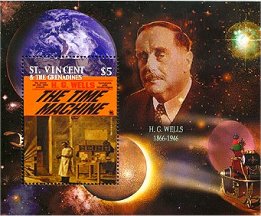
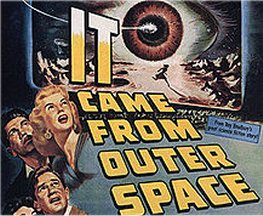
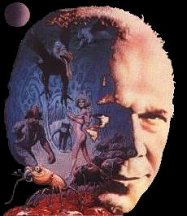

It Came From Outer SpaceFor some decades now I have been struggling with the problem of a new mythology for the scientific consciousness. When the old mythopoeic mythology was invalidated by science it left sort of a void in the human psyche. In the Arthurian sense we had entered the Wasteland of disappointed expectations, otherwise known as depression.
Over the last twenty years of unremitting labor I have been either trying to discover or create such an existing scientific mythology. Perhaps my efforts have been rewarded. I modestly offer the following for your approval.
Unlike the internet where I get most of what passes for news by current standards, this day I was reading the newspaper. I hadn't come to that, it was just lying handy and I had the idle moment. However, I read that our giant combined new and used Pulsar Book Store had laid off a couple dozen employees, or workers as they are sometimes amusingly described, because of declining in-store sales. I further read that sixty percent of Pulsar's sales were over the internet.

When The Student Is Ready…
I’ve been doing all my book buying over the internet and hadn’t been in the Pulsar store for years. Casting about for a reason for a decline in sales, apart from a growing illiteracy in the body politic, it occurred to me that on-line electronic transmission of books was cutting into book sales deeply. I mean, Amazon offers oodles of older books free, many of which you will never see in books stores, but are offered by Print On Demand publishers over the internet. Ask yourself when you last saw a Charles King? Lots of them for free on Amazon. That has to hurt sales. I then reasoned that Pulsar's shelves must be groaning. I might be able to find a superb selecion at good prices, and I was right.
I was rewarded with an armful of books at my first stop in the Bs. I picked an armful of hard-to-find Balzac titles dirt cheap, thousand page nineteenth century omnibus volumes for six dollars and ninety-five cents each, Good God Almighty. As close to heaven as you can get without taking the chance of dieing.
Then I bethought myself to check the H.G. Wells section. I have a complete collection of Wells' fiction but I'm still missing a few titles of the non-fiction. The Wells shelf was loaded and with cream, titles that I had had trouble finding over the years were now there in profusion. I had to laugh to see nearly a whole shelf loaded down with copies of Wells' Seven Science Fiction Novels in many editions. I bought my copy of that at sixteen when it became the foundation of my psychic reality. There were a number of editions I had never seen before. In a fit of curiosity and affection I pulled a copy out just to fondle it. As I did a small slim volume concealed between the two larger ones tumbled out and fell to the floor.
I picked the paperback up. It was by one Garrett P. Serviss titled Edison’s Conquest Of Mars and sub-titled as the Original 1898 Sequel To The War Of The Worlds. I laughed at what seemed ludicrous and slid it back on the shelf. I must not have been adept because it fell out on the floor again.
I stood looking at it for a few seconds then decided that a mysterious power was bidding me to read it. I know how ridiculous that sounds but it happens to me often and always with an important book for me to read. Call it serendipitous, call it destiny, I follow my star. They wanted nine ninety-nine for a paperback of two hundred pages. I had an armful of thousand page, hundred-year-old, hard backs on really good paper for six ninety-five each. I wavered. But then I rememberd the mysterious way it had been concealed between two books destiny knew I would look at. I thought of the old esoteric adage, when the student is ready the teacher will appear. This same thing had happened to me many times before. Often when my mind had been prepared a book had suggested itself. Here it was, deja vu all over again. Was I going to let a little literary bigotry stand between me and my obvious destiny? Not I. I begrudged the ten dollars but when I got home and examined the tiny volume I saw that I had discovered the missing link. I can now make a case for a new scientific mythology.

When It All Comes Down, I Hope It Lands On MeThe search for a new mythology goes on apace. Perhaps the catalyst in the organization of the search was a sci-fi writer named Philip Jose Farmer. Back in 1972 he formulated a scheme in his fantasy novel Tarzan Alive called the Wold Newton Universe. He provides a very rigorous framework for the search. Farmer posited that a meteorite fell to Earth near Wold Newton in the North of England in 1795, which is true, a meteorite did come down. He further posits following the lead of H.G. Wells novel In The Days Of The Comet that this 1795 comet produced a change in men’s minds, and in point of fact there was a change of consciousness that occurred at this exact time.
Several years ago, decades now, I bought a collection of the British magazine The Monthly Review, a run from 1781 to 1795. Isn’t this spooky? These volumes reflect a late medieval consciousness. As an example the volumes use f for s internally in a word -- paf try for pastry for instance -- while beginning and ending esses are the convention letter s. After 1800 this form disappears. I wondered at what precise time The Monthly Review changed its orthography. Through the wonders of the internet I was able to determine that precise date. It was at the beginning of 1796, the volume following the last I own. Thus 1795 is, in fact, a very good date for the change to the modern consciousness.
After 1795 then, EuroAmerica looked at reality with different and fresh eyes. Also a new literary style arose that led into the genre literatures of the present. A magic generation of writers then arose with one foot in the medieval world and the other in its successor, with modern orthography of course. Shelley and Byron, Peacock and the greatest of all, the father of modern fiction, Walter Scott. Scott has lost nearly all his glamor now but he was the presiding genius of nineteenth century fiction. I mention only the great French Bohemians Honore De Balzac and Alexandre Dumas. Toss in Edgar Allan Poe.

Searching For The Thread
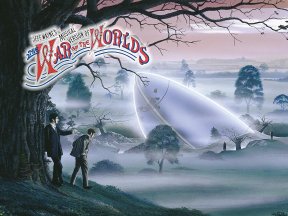
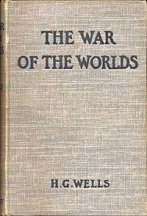
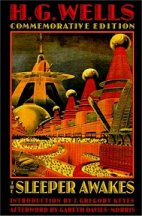
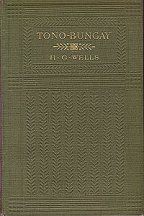
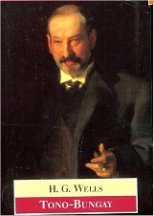
Thus in Tarzan Alive Philip Jose Farmer began a classification system for the new approach to mythology. Currently there are two Wold Newton systems - The French Wold Newton Universe and the Anglo-American. Generally speaking a Wold Newton author’s whole work, or the major part of it, is a series of novels, a roman a fleuve, built around a character or a theme, thus Conan Doyle's Sherlock Holmes, Baums Oz stories, or Edgar Rice Burroughs' Tarzan and John Carter/Mars stories. All the Wold Newton novels develop the new scientific mythology. Some themes are developed by several hands such as the Vampire corpus or that of Frankenstein/artificial life.A major writer falling somewhere between literary and Wold Newton fiction is H.G. Wells. He neither created a great fictional character nor works that fit easily into nor works that are exactly genre literature. Still, Wells is at the center of the Wold Newton mythology.
There are three novels of Wells that I think can fit into and define the Wold Newton Universe. These are The War Of The Worlds, When The Sleeper Wakes and Tono Bungay. With the exception of the Seven Science Fiction novels, of which only four have made an indelible impact, the rest of Wells' novelistic corpus is today disregarded having apparently no relevance to the modern world.
Of course I like Wells and I have read the entire fiction corpus. There are a few novels that I think merit attention but in the hundred years since they first began appearing the body of fiction that has been written obscures all but the brightest stars of novels so that vast amount of meritorious fiction is only read by the specialist or literary enthusiast exploring the past.
War Of The Worlds is what got me started on this investigation, isn’t it? I’ve read War Of The Worlds three or four times now and each time it's a new book and not the one portrayed on the screen or what I perceived from my childhood reading. I’ve come to the conclusion that the book isn’t really all that good although it has set the world on its ear. It must have played into the fears of a society desperately grappling with a sea change in history. Every conventional way of viewing the world was falling into the dust as the old mythology vaporized as before the Martian tripods and a new mythology was as invisible as Griffin in Wells' Invisible Man. When you removed the wrappings of Griffin there was nothing there but the invisible power of the past.
Perhaps Wells’ Martians symbolized the all too visible power of the new scientific reality destroying the old magical religious vision of reality. At any rate the book was received with startling avidity at its publication in 1898. And nowhere was this book seized upon with such voracity as in America. The effect has also been enduring including the radio broadcast of Orson Welles in 1938 and a number of movie treatments. We often think Wells created this genre but not so.
In fact the space opera centered on Mars was an exciting new genre that developed rapidly during the nineties and the first decade of the new century. Burroughs with his great Martian Trilogy was merely taking advantage of an established theme which he epitomized so well that his books are a culmination of Martian writing to that point. His were the apex of the nineteenth century Martian theme, a new starting point for the future.
He was apparently well read in the genre although apart from a few obvious titles one cant be sure how deeply he had read.
Robert Godwin explains in the introduction to Edison’s Conquest Of Mars:
Late in 1897 the great H.G. Wells struck gold when he submitted for publication- in Pearson’s Magazine of London- the future-war story to end all future-war stories, The War Of The Worlds. It was not the first story of aliens coming to Earth, Edgar Allan Poe had done that sixty years earlier. It was not even the first to involve humans fighting Martians, that had been done by Percy Greg in 1880, while German author Kurd Lasswitz had brought Martians to Earth to wage war with the British earlier that year. It was Wells who brought this novel idea home with star realism. The War Of The Worlds has little dialogue and few characters but is literally dripping with paranoia. His invading Martians were completely alien and they had the technology to rampage right across the capitol city of the most powerful nation on Earth. The War Of The Worlds soon appeared in America through the pages of Hearst’s Cosmopolitan Magazine.

Will This Nightmare Never End?Perhaps the dripping in paranoia was the key to Wells' American success. America is a very paranoid country and the paranoia is shared equally by both the Right and the Left. If War Of The Worlds dripped with paranoia it was as nothing compared to Wells’ next book, When The Sleeper Wakes. Sleeper is all bombs, sirens and searchlights playing across the dark night skies. Sleeper is the masterpiece of paranoia. I just love it. Wells must have been going through a period of deep anxiety when he wrote it. Sleeper is one great long anxiety attack which he translated into a fear of being buried alive. The hero, Graham, is actually buried alive although above ground. He’s placed in a glass case where he sleeps for a couple hundred years until one day he awakes to find himself in possession of all the wealth in the world. His money had been in trust gathering interest for all these centuries until his estate equalled the world’s wealth. Of course he is more dangerous awake than asleep so he begins running scared.
But that fear or paranois also characterized The War Of The Worlds which is one long flight from danger. Godwin continues:
Cosmopolitan was not cheap and so it would not be until the following January that the impressionable and imaginative young inventor Robert Goddard would first encounter Wells’ Martian war machines. Copyright laws in America were still somewhat tenuous and newspapers were at liberty to do as they pleased. Obtaining permission was often the last thing a newspaper editor would worry about and this modus operandi was especially prevalent in the smaller newspapers such as the New York Evening Journal, The Milwaukee Sentinel and the Boston Post. Many of these newspapers decided to jump on Wells’ bandwagon.A truly astounding development. Here was immediate impact to be followed forty years later by the even more astonishing reaction to Orson Wells radio script of the novel which was accepted as fact, real by the radio listeners who grabbed their shotguns and ran into the streets to repel the Martian invaders. Obviously the novel answered a deep seated psychological need of Americans which would be reflected in a series of movies such as The Day The Earth Stood Still with Gort an Klaatu as well as such later developments as Roswell, New Mexico and Area 51. Aliens and space were united to the New Mythology. Of course such aliens are only God thinly disguised. After all such characters as Klaatu are always preaching to us to mend our misbegotten ways or else. Religion or no religion.In the Boston Post, a Sunday, January 9th 1898, an entirely revised version of The War Of The Worlds appeared under the title Fighters From Mars -- or, The Terrible War Of The Worlds, as it Was Waged in or Near Boston in the year 1900. What is particularly remarkable about this is that the story is completely transposed from London to Boston. All of the familiar scenes which take place in south London are suddenly taking place in Concord Masschusetts. The Boston Post was fairly well circulated in the New England area and Robert Goddard soon learned of the remarkable serial. The Post certainly did their part to stoke the fires of enthusiasm, they repeated the first chapter the next day in Monday’s newspaper and then not a day went by for the next few weeks without another installment appearing. On the 3rd of February the serialization was complete and Wells’ great story was soon destined to appear in America as a full fledged book.
Then something altogether unexpected happened. The editors of the Boston Post revealed that they had acquired a “sequel” to Wells’ story, the advert in the Post read. “Edison’s Conquest Of Mars- A Sequel To ‘Fighters From Mars’… written in collaboration with Edison by Garrett P. Serviss the well known astronomical author.”

A Giant Leap For AmericansThe remarkable thing is that the Boston Post or one or more of its editors got a British copy in their hands, or the Cosmopolitan reprint, read it, and had his mind transformed on the spot immediately beginnning the transposition from London to Boston, while at the same time beginning he process to create a sequel that was ready to begin publishing as soon as the original finished. Plus Edison had to be immediately amenable to the idea so as to give his permission to use his name.
Now, all this is transpiring during the Spanish-American war and the insurrection in the Philippines. Also as if one phenomenon weren’t enough this was also the moment that Kipling’s poem The White Man's Burden appeared. Kipling’s poem was, of course, a commentary on the Philippine insurrection.
Serviss then had probably no more than a month to draft his sequel. Serviss himself had a scientific background which he fully employs in his sequel. He was up to date on Martian theory. As incredible as it may seem the book could have been a pilot for Star Trek. He got it all in one book. The Boston Post serialization ran and then the story disappeared. It never made book form at the time. In 1947 it was unearthed and published in a truncated form so unless by a miracle the Post episodes were seen by Edgar Rice Burroughs they had no influence on him although it seems like they could have. However, Percival Lowell the astronomer who is often mentioned as an influence on Burroughs was from Boston. By 1899 he had already established his observatory in Flagstaff and written the first of his three Martian books, ‘Mars.’ He might then have had an influence on Serviss. Lowell’s other two Martian books, Mars And The Canals and Mars As The Abode Of Life written in 1906 and 1908 respectively might have been influenced by Serviss. As a budding Mars expert it is likely that he might have had his attention called to both Wells’ and Serviss’ efforts. If Burroughs read Lowell he would have been indirectly influenced by Serviss. Anyway Serviss has a full discussion of how the water imagined to be on Mars flowed from the South to the North because the South Pole was thought to be elevated over the North and water, of course, flows down hill. Serviss doesn’t explain how the water gets back to the South Pole.
Serviss and undoubtedly Lowell have the water flowing on the surface so Burroughs has it flowing underground somehow.
At the time Edison’s reputation was at its zenith as a technologist. He was the epitome of the American can-do attitude. Serviss was pretty fair at this first attempt at sci-fi. One has to assume that all the scientific ideas were in the air, but Serviss skillfully blends them together in that can-do attitude within virtually days.
Edison creates a fleet of anti-gravity ships within thirty days. The anti-gravity ship is a plausible way of inter-planetary travel while the ships are designed in the projectile shape of current rockets. The disintegrator guns Edison designs, also within thirty days, eliminate the bonds between atoms also in a plausible manner thus scattering the stricken entity to the winds.
Thus, a few years before the Wrights, not only does Edison have heavier than air craft but the Martians have huge air fleets along the line of Burroughs. So, as I say, Burroughs was stepping into an established genre not originating anything.
Serviss merely makes the Martians giants so we essentially have a Gullivar and the Lilliputians story reversed. It’s a reasonably good story while being a very proper scientific novel. There is nothing really for future writers to add, just rearrange the details. And that was in 1899.
The Boston response to the invasion from Mars was to ‘organize’ its own invasion of Mars and annihilate them as a psychological projection. Very interesting.

From One Dark Spot To AnotherI have found no response from Wells to this rewrite of War Of The Worlds and its sequel. H.G. got busy writing another fantastic futuristic sci fi effort title, When The Sleeper Wakes. This book can actually be bundled with 1909's Tono Bungay. Both wonderful paranoid books. These two books plus War Of The Worlds form the core of my psyche and if the truth were known probably a large part of the psyche of Edgar Rice Burroughs; most especially he was influenced by Tono Bungay which can be readily traced.
Sleeper is a wonderfully paranoid tone poem. By 1898-99 Wells was realizing his ambition of rising above his origins while his Anima-Animus problem was becoming paramount. Wells was born into the lower social level of society with almost no hope of realizing his considerable potential. He was seemingly condemned to a life as a Draper’s Assistant which was little above servitude or even slavery. On his own efforts he rebelled seeking a way out through education. He achieved this after enduring several years on the razor’s edge uncertain as to what his future would be. Combining his scientific background with his literary skills he began to rise above his origins financially although he was never to escape the psychological stigma of his lower class origins.
Thus through his short stories which were sensational at the time, and some still are, he got a foothold in the literary scene. Wells wrote at least two or three masterpieces. His The Time Machine put him in the writer’s top notch class. War Of The Worlds and When The Sleeper Wakes, close to a diptich, written out of acute anxiety as to his future put him over the top. He was a force to be reckoned with.
Thus both novels pit his heroes against overwhelming forces that they must defeat. In the War Of The Worlds the enemies fade away through natural causes. In Sleeper, Graham the Sleeper, awakes to find himself the richest man in the world only to discover that all is to be taken away from him. This is normal anxiety for someone on the rise. The new man is always resented and his way made difficult. He is to be prevented if possible. Hence the intense fear and paranoia of Sleeper. In the denouement Graham takes to the air in the last remaining airship to single handedly drive back the Negro police summoned from Africa. Prescient really. The Sleeper’s plane spirals into a crash, but then Wells takes the copout that it is only a dream. At any rate in real life he wakes up to find that he is now a guru. His non-fiction Anticipations -- a guide to the future -- published two years later in 1901 established him irrevocably as a ‘futurist’. All he had do then was write passable books.
Both of his masterpieces Worlds and Sleeper also dealt with Wells’ troubled sexuality. As in the life of all men his Anima became estranged from his Animus which Wells was never able to reconcile as he developed a rather bizarre sex life as he searched for a way to recover his Anima.
In WOW as the populace was fleeing the Martians his hero was driving a cart along with his Anima figure. The two became separated when a crowd came between them and she was lost. In Sleeper Graham finds his Anma but once gain events separate them and he is about to crash his plane alone.
And then ten years later Wells crowned his work with the very wonderful Tono Bungay. Not close to the finest story ever told, it is nevertheless one of the world’s great novels. The book had a profound influence on me. I first read it when I was twenty, while I have subsequently read the book three times. I cherish my first reading because I projected myself into the story so much that I rewrote the book in my imagination to suit my own needs. Tono Bungay was an entirely new book in my last reading. I hope to show that the book had a profound influence on Edgar Rice Burroughs as his and Wells lives touched as the 1930s arrived. It’s always a strange world.
Wells seems to have been interested in the patent medicine businss in the US during the first decade of the century. Strangely it is not impossible that the story refers to the situation of a Dr. Stace of Chicago. I’m just guessing now. Stace’s partner was a young man named Edgar Rice Burroughs. So it may be coincidence that Edward Ponderevo, the inventor of the tonic Tono Bungay, and George Ponderevo his nephew, may have been based in part on Stace and Burroughs. I mean, the patent medicine stories are identical. Probably a coincidence though but I’m just guessing.
During the first decade of the twentieth century the patent medicine business had developed in the United States to magnificent proportions. As great national magazines arose the potential of the business rose accordingly. The active ingredient in the patents was usually alcohol, although drugs which were unregulated, were frequently used. It is well known, for instance, that the Coca in Coca Cola referred to the cocaine with which the drink was laced. Coke was a real pick me up back then. Amphetamines were isolated in 1897 so imagine Methedrine Cola. Quite an idea.
The US government saw the dangers of these patent medicines, not a few of which used the opium based laudanum. I mean, these were loose times, they used to give infants opium based laudamun to keep them quiet. Better than TV. So, during the teens the government was forced to conduct a campaign against patent medicines. First they came for the patent medicines then they came for the alcohol and then they came for the cigarettes. Now they’re working on sugar and salt and caffeine. You’re next, you miserable user you. Wells was watching this fascinating activity from Britain. In one instance Edward Ponderevo remarks that six or seven go-getter Americans would wake England up. Then he invented Tono Bungay, the patent medicine par excellence.
Strangely, leading the anti-patent medicine campaign in the US was Samuel Hopkins Adams who would affect Stace-Burroughs then and sixteen years or so later would upset Burroughs’ life when he published his very successful novel, Flaming Youth. Strangely, strangely how many people who have never met can be so influential on others. Almost paranormal.
So, Burroughs took up with Stace in the sale of patent medicines just as the government was cracking down on them, putting them out of business, filing legal complaints, doing the double nasty. Stace and Burroughs developed a close relationship, almost as close as father and son or, uncle and nephew. Even after the two were put out of business they continued in another line of business before parting. Erwin Porges in his biograpy of ERB doesn’t go into a lot of detail over this relationship, maybe from a mistaken sense of delicacy, but this was a big event in Burroughs’ life perhaps straining his marriage with Emma. I believe it was here that he gained his personal experience of sheriffs and grand juries.
Stace may have been a big enough operator to come to Wells’ attention so that he was captivated by this story of the older man and his younger acolyte.
At any rate Edward Ponderevo goes bust in a provincial town through his aggressive business practices removing to London where he develops the idea of Tono Bungay. Wells then diverges from the patent medicine story as Ponderevo, who was a real go-getter, develops an empire based on legitimate products, like soap, so that Tono Bungay takes a back seat in his success story.
Interestingly Ponderevo buys a huge estate not unlike Tarzana around which he begins to build a ten foot high wall some eleven miles in length. Then, of course, he overextends himself and goes bust.
In reading this story, as I’m sure Burroughs did, he must have really related to the patent medicine story, while probably rewriting the story in his mind to suit his circumstances. In this story too, Wells finds his perfect soul mate or Anima who once again he loses.
If by chance Wells was aware of the Stace story and did know he had a junior partner, Burroughs, he undoubtely forgot about him and the patent medicine business in the turmoil of the years to come.
The story of Ponderevo, his large estate and the eleven mile ten foot high wall must have stuck in Burroughs’ mind. The story may have been instrumental in his decision to buy Tarzana while it appears spectacularly in 1933's Tarzan And The Lion Man.
Let me say that this whole group of writers who would nearly all find a place in the Wold Newton Universe read each other. While Kipling, Haggard, Wells and Doyle were reading Burroughs after he became famous as well. Indeed, Wells in Sleeper mentions three stories that had a profound effect on all these writers: Kipling’s The Man Who Would Be King, Conrad’s Heart Of Darkness and Henry James’ The Madonna Of The Future. Writers appearing after ERB’s fame appear to have been universally influenced by his, too. Haggard and Kipling’s Love Eternal was a response to ERB's The Eternal Lover and unless I’m oversensitive they talked to him in it, too.
In a way then this was a form of telepathy, so controversial a topic at the time -- true long distance communication and this would continue through the thirties if you’ve read enough and thought about it.
Anyway, Burroughs read extensively incorporating almost everything that impressed him into his stories one way and sometime or other. I’m sure he was unconscious of using most of the sources. Thus the story of Tono Bungay, Ponderevo and the ten foot fence entered his subconscious.
In 1919 ERB left Chicago for LA for good. His intent was to buy twenty acres or so to raise hogs. This he could easily have afforded avoiding all the subsequent economic pain. However, Harrisons Gray Otis, the publisher of the LA Times had died in 1917 and his 540 acre estate, Rancho Del Cabrillo, was on the market. ERB made an abrupt about face and bought it. I’ve often wondered why, what was the impetus? If one reads of Ponderevo’s estate in England one has a pretty good match of Tarzana. Burroughs has been quoted as saying he would have liked to have a large estate that he could build a ten foot high wall around. Of course he had the estate and lost it. But the Ponderevo estate seems to have been on his mind.
This may sound completely conjectural but let’s move ahead to 1933 when ERB penned what I consider his magnum opus, Tarzan And The Lion Man. He includes a novella in the story that might be entitled, Tarzan And The City Of God. This is a pretty good story. By 1933 the talkies had been in existence for five years. Many of the more magnificent early horror stories had already been filmed. I may be a sucker for these early horror films but given the limitations of the industry at the time they have never been equaled. So, in addition to all the books stored in ERB’s mind, fifteen years or so of silent films, he now added a full catalog of talkies. Himself a virtual father of all B movies with his own catalog of novels, all these B horror films reinforced his imagination. Even though he had little to do with the filming of his own movie starring Herman Brix as Tarzan, The New Adventures Of Tarzan, the movie was nevertheless perfect of the B genre. Sort of an a correction and example to MGM.
Tarzan And The City Of God is perfect in the Pulp genre which is the literary counterpart of the B movie but now ERB seamlessly joins the Pulp to the B genre.
Tarzan And The Lion Man mocks the making of MGM’s film, Trader Horn. As I have pointed out in other reviews, in 1931 ERB signed a contract with MGM that removed the Tarzan character in the movies from his control to MGM. MGM then proceeded to mock the Tarzan character on the screen in an attempt to destroy ERB’s creation. Of course, the mockery failed, Tarzan going on to greater glory and an immortality he might not have attained otherwise.
At the same time ERB was locked in a battle with Joseph Stalin and, at the risk of seeming preposterous, the Soviet Union. This war was brought to the surface n 1930's Tarzan The Invincible. Now, Stalin and the Communists of all countries were attempting to discredit all pre-Revolutionary writers who rejected the Communist program. ERB was one of these while, oddly, Tarzan was one of Stalin’s favorite characters, especially in the MGM movies.
H.G. Wells who accepted the Revolution in substitution for God in about 1920 was one of Stalin’s literary hatchet men. During this period Stalin assigned State prostitutes to service certain Western literary men to report back to him on their doings. Moura Budberg had been assigned to H.G. Wells. Amazingly Wells fell deeply in love with her although he had to have known that he was her job. One of Wells’ targets was Edgar Rice Burroughs. Thus beginning in the twenties Wells began parodying and vilifying Burroughs in various books to which Burroughs replied in other of his own books. Thus, in a sense, there was telepathic communication.
In 1933 the combined attack of MGM, one imagines Louis B. Mayer, Wells and Stalin had overwhelmed Burroughs.
In 1930's Tarzan The Invincible Burroughs had been forced to abandon the valley of Opar and La to Wellsian and Soviet interference. The Communists invaded Opar destroying ERB’s imagined paradise. So now, in a masterful creation he attacks Wells, MGM and the Communists in the City of God, London, England transposed to the Mutia Escarpment in Africa The Mutia Escarpment was MGM’s imaginary location for the Tarzan movies named after an African actor who appeared in Trader Horn. We do have telepathic communication here if you’ve got your radio turned on and tuned in. So there is layer after layer of mockeries in what is actually a titanic combat involving film and literature carried on right before the eyes of an unseeing world. Stalin, Burroughs, Wells and L.B. Mayer knew, but virtually no one else. I might never have caught on but for the internet and the availability of films on DVD and flat screen TVs programmed through my wireless computer network. I have a complete collection of ERB’s novels, nearly all of Wells, and a nearly complete collection of Tarzan DVD’s. There’s always one or two that elude you. So I can read and watch at will. Rather amazing really. All one’s intellectual influences on one shelf while every library and film archive is only a click away. Isn’t God good to us?
So, Tarzan scales the Mutia Escarpment which at his point of attack is a sheer wall of granite. This probably indicates the difficulties ERB was facing. As usual there is an easier ascent for the ladies but Tarzan knows nothing of it. In real life, the location of Van Dyke’s Trader Horn was Murchison Falls on the Nile and the plateau would have been the land around Lake Victoria.
On the plateau Tarzan approaches the City of God/London which is surrounded by a, guess what, ten foot high wall. The circumference must have been at least eleven miles. Thus we have a replica of Ponderevo’s estate as imagined by H.G. Wells of London, England. Instead of Ponderevo’s modern ‘castle’ we have a replica of what might be Frankenstein’s castle or some othe horror film castle with the requisite village at its base.
Now, ‘God’ who was a ‘formerly handsome Englishman’ had come to this country in 1859. This is now 1933 so 74 years previously. As God will tell Tarzan shortly he was a biological scientist experimenting in evolution and creating artificial life a la Frankenstein, when his studies involving corpses brought the authorities down on him forcing him to flee England but not before he had removed, essentially DNA, which ERB calls ‘germs’, from the corpses of Henry VIII and his court buried in Westminster Abbey. In London, Africa God had forced the evolution of a tribe of gorillas turning them into barbaric replicas of Henry VIII and his court. Still having the appearance of gorillas they have more or less human minds speaking and acting as archaic Englishmen.
Tarzan having scaled the impossible cliffs of the plateau is now faced with a ten foot wall with sharply pointed wooden stakes pointing downward making a leap and hoist impossible. ERB has left out the overarching tree in this instance so Tarzan does his strongman act. The body builders are never far from ERB’s imagination. Tarzan pulls off an impossible stunt. Leaping up he grabs a couple stakes lifting himself over his wrists until he was above the wall then rolled forward. Only time that trick’s ever been performed. Thus ERB enters that ‘sacred city.’ The sort of Troy that refused Achilles.
The scaling of the cliffs, the clearing of the wall might have been suggested to ERB by his struggle to achieve success which he had done for one brief moment. Lifting himself by his bootstraps, as it were, he had gained entry into that sacred city. His success was to be shortlived and almost as tragic as Tarzan’s visit to the City of God or ERB’s Tarzana or Ponderevo’s estate.
While Wells was born to poverty, ERB’s course in life had been different; he was a Golden Child with the highest expectations. And then in his teens it was all taken from him as he was plunged into poverty although not as abject as he makes it out to be. Thus he had a different personal myth than that of Wells. He identified with Mark Twain’s Prince And The Pauper in which the Prince changes places with his impoverished doppelganger, then regains his position. His other favorite book of this type was Little Lord Fauntleroy in which a British heir lives a normal life in America until he inherits his English title. Thus these two books combined with Tono Bungay suggested a course to his life that he actually realized and as the three titles suggest lived his life in a boom and bust fashion. as though compelled to gain and lose, lose and gain his fortunes until he died in bed a comparatively well off man. ERB was a very suggestible guy. At this point in his life he was heading into a major bust part of the cycle and this story tells of it.
Once inside the walls there sits the castle, The City of God, the City on the Hill, the sacred city of Achilles, his goal. Tarzan mounts a very long flight of steep stairs as ‘God high above on the castle ramparts watches with grim satisfaction. the fly has come to the spider. Just like L.B. Mayer and MGM he’s got his man all but trapped.
Having just been trapped by his enemies ERB belatedly has it all figured out. Tarzan enters a foyer faced by three doors. At this point all decisions are Tarzan’s. He can go back or he can go forward. He elects to go on. Two of the doors are locked while one is ajar. This scene of Tarzan and the doors is repeated several times in the corpus. I’ve tried to figure it out. The nearest I can come is a short story of 1898 by Frank Stockton titled "The Lady Or The Tiger."
Since this was a very famous story I, for myself, have no doubt that ERB read it and was suitably impressed. This is arbitrary, I know, however there is a great deal of similarity between this story and the story of Queen Nemone and Tarzan in the arena from Tarzan And The City Of Gold. Now, in "The Lady Or The Tiger" the story hinges on two doors, behind one of which is a tiger and the other a gorgeous lady. This is the trial by ordeal that Stockton’s king has chosen to decide his criminal cases. In his story a young lowly man has dared to love the king’s daughter. She is in attendance but displeased because the lover will possible marry another. She indicates to him to take the right hand door. The question is left unanswered whether the lady or the tiger was behind the door by Stockton leaving it to the reader whether the one or the other was the man’s fate.
In the city of God, of course, the choice has been made for Tarzan as the middle door is left unlatched. Tarzan enters descends some steps, passes through another door that latches behind him to find himself facing…the lady. Well, I don't know, could be unrelated to Stockton’s story, but then, again….
At any rate it relates to ERB’s obsessions with tigers. As we all know the magazine story of Tarzan Of The Apes had both tigers and lions that public opinion forced Tarzan to change as the literalists pointed out that there were no tigers in Africa. ERB changed the tiger to a lioness he called Sabor so that female lions can be thought of as tigers. I think most of the lions Tarzan kills are females. If tigers and ladies are associated in ERB’s mind then in City of God Tarzan got both the symbol and the real thing, who was his preferred Anima figure Rhonda. I’m pretty sure that’s how ERB’s mind worked.
Speaking of tigers, for those lovers of the Pulp and B movie genres, a perfect of its kind, the grande finale of the genre so to speak is Fritz Lang’s Indian diptich The Tiger Of Eschnapur and The Indian Tomb of 1959. Set in India but pure Burroughs with plenty of tigers, as there are no lions in India as everyone knows. Stunning color and the perfect pulp story of the twenties and thirties. Three or four hours of bliss.
So Tarzan/ERB is in a cage with his other half, his Anima. He’s been in tight spots before but this is it, the real thing, the place that’s a leap too far. Rider Haggard all over again. While the Big Guy and Rhonda are talking things over their captor, ‘God’, makes his appearance. A jolly fellow, a formerly handsome Englishman, now piebald, who might go by the name of H.G. Wells.
As I said Wells is one of my favorites and when I was younger and slightly more obtuse Wells struck me as he probably did ERB as a stunning writer. Later as I learned of Wells’ politics and other failings he lost much of his gitter but the glory pretty much remains although resented. Burroughs had much more reason to consider Wells a ‘formerly handsome Englishman’. Thus he takes a certain malicious pleasure in making his God character half black, half white, half ape and half human. There’s a lot more to analyze in the character of God but I’m working this side of the track right now.
The reason God is half and half is because as he aged he took germ cells from the apes to rejuvenate himself thus slowly adopting ape characteristis, regressing as it were in an evolutionary sense and making a fine joke on the Stokes Trial in Tennessee of a few years earlier. God is delighted to have captured two such fine White DNA specimens as he hopes their germ cells may restore him to his former splendor.
We’ll never know now because while God absents himself, in the best pulp/B movie fashion Tarzan feels a breeze stirring. This leads to what is hopefully an escape oute but merely turns into an avenue leading to Tarzan’s Gotterdamerung. A fire starts rising up through the flue Tarzan found and ascended so that the whole City of God on the hill perishes in flames.
While Burroughs may have said back in the teens that he had never read Wells, that may be dismissed. Actually when one delves behind the obvious facts one finds a fairly intimate connection with their careers contacting on the psychological level, that is to say ‘telepathically’, several times. Between Wells and Burroughs almost continuously from, say, 1908 to the thirties.
If one assumes that Wells was aware of the Stace-Burroughs situation, which is only a possibility, then Wells formed part of Burroughs subconscious with his Tono Bungay. That influence probably surfaced when Burroughs purchased Tarzana and then became continuous through the twenties and thirties when Wells became Stalin’s literary hatchet man.
Wells eludes the Wold Newton because he never created a mythic character or series of novels although the psychological situations of the seven science fiction novels and Tono Bungay along with many of his short stories give him a significant place in the Wold Newton mythos. The WNU is of course a state of mind giving mythological form to history since 1795 when the meteor landed altering consciousness.

WEB REFS
List of Wold Newton Universe Characters
A Listing of Philip José Farmer's Wold Newton Works
Wold Newton Family: Wikipedia
Wold Newton Pulp TimelineH. G. Wells: Wikipedia
Edison’s Conquest Of Mars: Wikipedia
Charles KingTarzan Alive
Edgar Rice Burroughs
War of the Worlds: TEXT
War of the Worlds: Wikipedia
The Sleeper Wakes: TEXT
The Sleeper Wakes: Wikipedia
Tono Bungay: TEXT
Tono-Bungay: Wikipedia
|
dugwarbaby@yahoo.com Meet R. E. Prindle and Follow the Navigation Chart for the Entire Series of Articles |
|
Differing viewpoints are welcome. |
|
are not necessarily those held by Edgar Rice Burroughs, Inc. |
![]()

![]()
![]()
BILL
HILLMAN: Editor and Webmaster
BILL
AND SUE-ON HILLMAN ECLECTIC STUDIO
ERB
Text, ERB Images and Tarzan® are ©Edgar Rice Burroughs, Inc.-
All Rights Reserved.
All
Original Work ©1996-2011 by Bill Hillman and/or Contributing Authors/Owners
No
part of this web site may be reproduced without permission from the respective
owners.